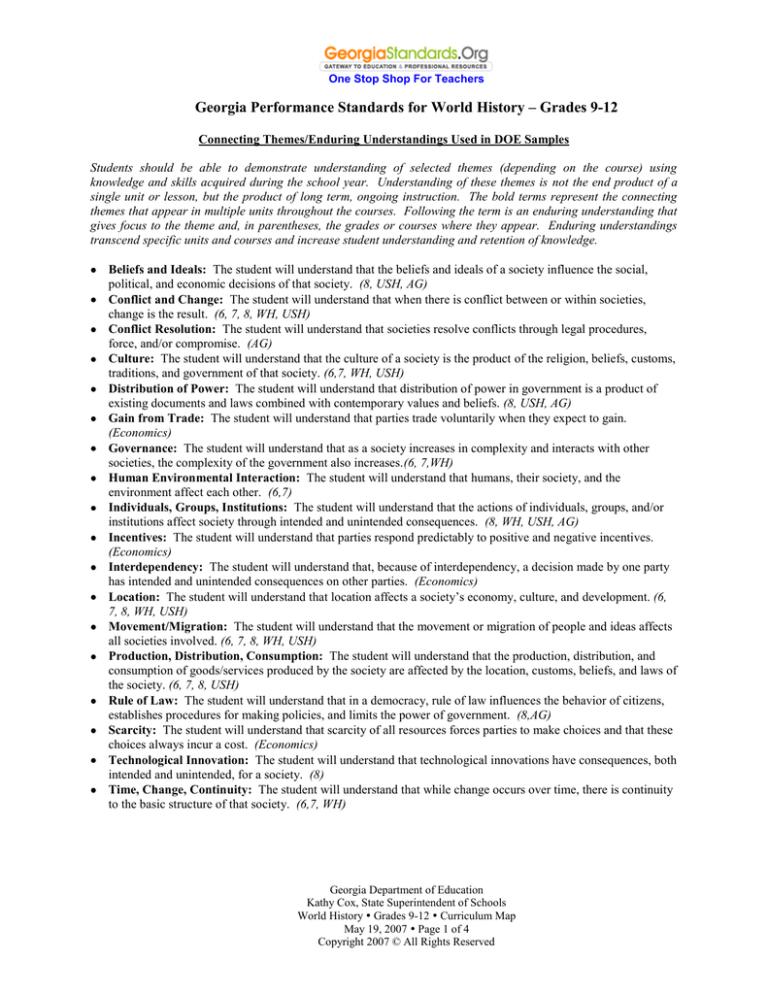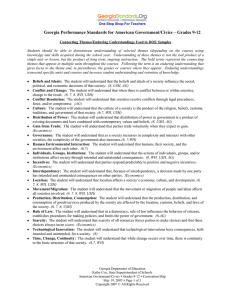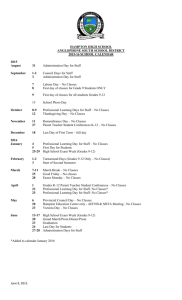
One Stop Shop For Teachers
Georgia Performance Standards for World History – Grades 9-12
Connecting Themes/Enduring Understandings Used in DOE Samples
Students should be able to demonstrate understanding of selected themes (depending on the course) using
knowledge and skills acquired during the school year. Understanding of these themes is not the end product of a
single unit or lesson, but the product of long term, ongoing instruction. The bold terms represent the connecting
themes that appear in multiple units throughout the courses. Following the term is an enduring understanding that
gives focus to the theme and, in parentheses, the grades or courses where they appear. Enduring understandings
transcend specific units and courses and increase student understanding and retention of knowledge.
Beliefs and Ideals: The student will understand that the beliefs and ideals of a society influence the social,
political, and economic decisions of that society. (8, USH, AG)
Conflict and Change: The student will understand that when there is conflict between or within societies,
change is the result. (6, 7, 8, WH, USH)
Conflict Resolution: The student will understand that societies resolve conflicts through legal procedures,
force, and/or compromise. (AG)
Culture: The student will understand that the culture of a society is the product of the religion, beliefs, customs,
traditions, and government of that society. (6,7, WH, USH)
Distribution of Power: The student will understand that distribution of power in government is a product of
existing documents and laws combined with contemporary values and beliefs. (8, USH, AG)
Gain from Trade: The student will understand that parties trade voluntarily when they expect to gain.
(Economics)
Governance: The student will understand that as a society increases in complexity and interacts with other
societies, the complexity of the government also increases.(6, 7,WH)
Human Environmental Interaction: The student will understand that humans, their society, and the
environment affect each other. (6,7)
Individuals, Groups, Institutions: The student will understand that the actions of individuals, groups, and/or
institutions affect society through intended and unintended consequences. (8, WH, USH, AG)
Incentives: The student will understand that parties respond predictably to positive and negative incentives.
(Economics)
Interdependency: The student will understand that, because of interdependency, a decision made by one party
has intended and unintended consequences on other parties. (Economics)
Location: The student will understand that location affects a society’s economy, culture, and development. (6,
7, 8, WH, USH)
Movement/Migration: The student will understand that the movement or migration of people and ideas affects
all societies involved. (6, 7, 8, WH, USH)
Production, Distribution, Consumption: The student will understand that the production, distribution, and
consumption of goods/services produced by the society are affected by the location, customs, beliefs, and laws of
the society. (6, 7, 8, USH)
Rule of Law: The student will understand that in a democracy, rule of law influences the behavior of citizens,
establishes procedures for making policies, and limits the power of government. (8,AG)
Scarcity: The student will understand that scarcity of all resources forces parties to make choices and that these
choices always incur a cost. (Economics)
Technological Innovation: The student will understand that technological innovations have consequences, both
intended and unintended, for a society. (8)
Time, Change, Continuity: The student will understand that while change occurs over time, there is continuity
to the basic structure of that society. (6,7, WH)
Georgia Department of Education
Kathy Cox, State Superintendent of Schools
World History Grades 9-12 Curriculum Map
May 19, 2007 Page 1 of 4
Copyright 2007 © All Rights Reserved
One Stop Shop For Educators
The following instructional plan is part of a GaDOE collection of Unit Frameworks, Performance Tasks, examples of Student Work, and Teacher Commentary. Many more
GaDOE approved instructional plans are available by using the Search Standards feature located on GeorgiaStandards.Org.
Georgia Performance Standards for World History – Grades 9-12
Standards: The focus of this important
Standards: 1; 2a; 6a; 8
Standards: 2a, b, c, d; 3
Standards: 4; 5; 6b-d
Unit Two focus:
Unit Three focus:
Classical Empires
Unit Four focus:
Empires and Kingdoms:
first unit is on the concepts and enduing
understandings rather than specific standards
Unit One focus:
Concepts found in
World History
CONFLICT & CHANGE
CULTURE
GOVERNANCE
INDIVIDUAL, GROUPS &
INSTITUTIONS
LOCATION
MOVEMENT/
MIGRATION
TECHNOLOGICAL
INNOVATION
TIME, CHANGE &
CONTINUITY
First Civilizations:
Social Complexity and the Need
for Order
CULTURE
Religious development (1b,c;
2b,d)
Writing and language (1e)
Comparing cultures of MesoAmerica (8b)
GOVERNANCE
Relationship of religion and
authority (1b; 2b)
Development of governments
(2c)
Rise and fall of Meso-American
civilizations (8a)
LOCATION
Importance of location to first
civilizations (1a; 2a)
MOVEMENT/MIGRATION
Trade networks (1d; 2b)
Cultural diffusion (2d)
Migration patterns (6a)
Growth and Expansion
CONFLICT & CHANGE
Collapse of Western Roman
Empire (3e)
CULTURE
Religious development (2b; 3d)
Development of Chinese
culture (2d)
Development of
Hellenistic/Roman culture (3c)
Development (2a)
GOVERNANCE
Evolution of Chinese
governments (2c)
Development of Greek and
Roman governments (3a)
INDIVIDUALS, GROUPS &
INSTITUTIONS
Famous Greeks and Romans
(3b)
MOVEMENT/MIGRATION
Cultural diffusion (2d)
Georgia Department of Education
Kathy Cox, State Superintendent of Schools
World History Grades 9-12 Curriculum Map
May 19, 2007 Page 2 of 4
Copyright 2007 © All Rights Reserved
CONFLICT & CHANGE
Orthodox Christianity and the Schism (4f)
Sunni/Shi’a Split (5c)
Crusades (5e)
Decline of Sudanic Kingdoms (6b)
CULTURE
Cultural and religious development in
Byzantium (4b; 4c)
Religions (5g)
INDIVIDUALS, GROUPS & INSTITUTIONS
Important Islamic scholars (5d)
Important Africans (6b)
LOCATION
Constantinople (4d)
MOVEMENT/MIGRATION
Byzantium/Russian relations (4e)
Diffusion of Islam (5a,b)
Expansion of Mongol Empire (5f)
African relations (6c,d)
TIME, CHANGE & CONTINUITY
Relationship of Byzantine and Roman
Empires (4a)
One Stop Shop For Teachers
Georgia Performance Standards for World History – Grades 9-12
Standards: 7, 9
Standards: 10, 12, 13a
Standards: 11, 13b, 14, 15
Standards: 16, 17, 18
Unit Five focus:
Emergence of Modern Europe
Unit Six focus:
The Emerging Global World
Unit Seven focus:
Mounting Global Tensions
Unit Eight focus:
The World at War
CONFLICT & CHANGE
Reformation/religious
changes (9d,e,f)
INDIVIDUAL, GROUPS &
INSTITUTIONS
Important Explorers of the
time (10a)
Important Ottoman Rulers
(12a)
Important European
Scientists (13a)
CONFLICT & CHANGE
European/Asian interactions
(11a; 14d)
Absolutism and revolutions
(14b,c)
Reaction to foreign
domination (15c)
CONFLICT & CHANGE
GOVERNANCE
Absolutism (14a)
Nation States (15b)
World Imperialism (15d)
GOVERNANCE
GOVERNANCE
Manorial/Feudalism (7a)
Relationship of religion and
authority (7b)
INDIVIDUAL, GROUPS &
INSTITUTIONS
Important Europeans of the
time (9)
Role of the church (7c)
MOVEMENT/MIGRATION
Growth of towns/cities (7d)
TECHNOLOGICAL
INNOVATION
Printing press (9g)
TIME, CHANGE, &
CONTINUITY
Social changes in Europe
(9a,b,c)
LOCATION
Geographical extent of the
Ottoman Empire (12a)
MOVEMENT/MIGRATION
Columbian Exchange (10b)
Muslim influence on laws,
religion, arts (12b)
TECHNOLOGICAL
INNOVATION
Role of technology in
exploration (10c)
Contributions of EuroScientists (13a)
INDIVIDUAL, GROUPS &
INSTITUTIONS
Important rulers/dictators
(11a; 14a,c)
Important writers/thinkers
(13b; 14a)
MOVEMENT/MIGRATION
Impact of population growth
(11b)
TECHNOLOGICAL
INNOVATION
Industrialization (15a)
Georgia Department of Education
Kathy Cox, State Superintendent of Schools
World History Grades 9-12 Curriculum Map
May 19, 2007 Page 3 of 4
Copyright 2007 © All Rights Reserved
Various aspects of WWI (16)
World totalitarianism (17b,c,d)
Events causing WWII (17f)
Various aspects of WWII (18a,c,d)
CULTURE
Impact of war on culture (17a)
Totalitarianism vs. Authoritarianism (17e)
INDIVIDUAL, GROUPS & INSTITUTIONS
Important people connected to WWII (17b,
c; 18c)
Influential people of the era (17d)
Ideologies related to the holocaust (18b)
One Stop Shop For Teachers
Georgia Performance Standards for World History – Grades 9-12
Standards: 19, 20, 21
Unit Nine focus:
The Contemporary
World
CONFLICT & CHANGE
Emerging nations (19a,b;
20a,b)
GOVERNANCE
Changing Russian
Government (19d)
INDIVIDUALS, GROUPS
& INSTITUTIONS
Important people of the time
(19d; 20d)
MOVEMENT/
MIGRATION
Global economic and political
connections (21b)
TECHNOLOGICAL
INNOVATION
Arms race (19c)
Modern developments (21a)
Georgia Department of Education
Kathy Cox, State Superintendent of Schools
World History Grades 9-12 Curriculum Map
May 19, 2007 Page 4 of 4
Copyright 2007 © All Rights Reserved



